If there are no new ideas, why not look to the oldest idea generator around — evolution.
The concept of using nature as inspiration for mechanical design has been around for a long time. What young engineer hasn’t heard the story of George de Mestral, the Swiss electrical engineer who invented Velcro? de Mestral famously took his dog for a hike, and upon returning home covered with burrs, examined them through a microscope. Inspired by their tiny hooks that latched on to loops in his clothing, he went on to develop the ubiquitous fastener.
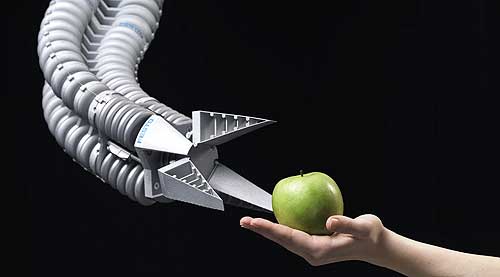
Where robotics is concerned, using nature has often focused on the human form. Even in television and film, we grew up with humanoid assistants on Lost in Space, The Jetsons and the Star Wars movies. Here in the real world, the arm-shaped machinery in auto manufacturing plants have probably been synonymous with what a robot means to most people.
Today, the expanding field of what is now called biomimicry is giving engineers one more tool in their arsenal of design ideas. After all, what is evolution but millions of years of field tests?
The core of biomimicry
Is biomimicry using natural design as simple engineering inspiration, or is it more of a reverse engineering of nature?
Howie Choset, Professor of Robotics at Carnegie Mellon University’s Robotics Institute, has worked with many different kinds of robots, including a variety of robotic snakes.
Snake robots
Biological inspiration: Snakes
Developed by: Carnegie Mellon University’s Robotics Institute
These robots are highly articulated mechanisms that can thread through tightly packed volumes, reaching locations that people and machinery otherwise cannot. Their ability to move through a myriad of terrains suggests a broad range of applications: They are likely the only mechanism that can traverse a field, swim through a small pond, breech a fence and then climb a flag pole.
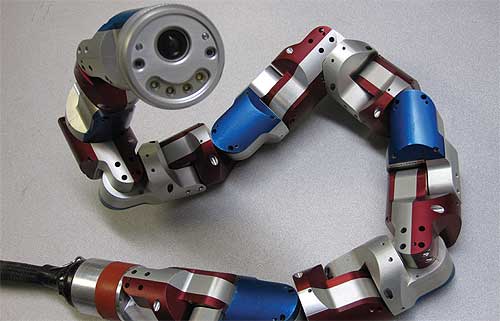
They can move into and through areas in a minimally invasive manner, which is important for military rescue operations, since they do not disturb potentially fragile situations, and for surveillance missions, since they can covertly access hard to reach locations. They can also be used for battlefield medicine in applying therapies in the field. Finally, these robots can be used for infrastructure inspection.
The university’s family of modular snake robots have demonstrated a variety of locomotion capabilities, including climbing up a 50-ft crack in a building, climbing up stairs, swimming in a pond, climbing along a pole, falling one story, crawling through floor spaces and maneuvering through brush.
“For me, biomimicry does not mean reverse engineering, it doesn’t mean go copy biology,” said Choset. “What biomimicry means is go get inspired by biology and the lessons that nature has already figured out. Use nature as a goal you want to pursue, use nature as a rough blueprint … With the snake robots, they crawl like snakes and they look a little like snakes and they’re highly articulated like snakes, but snakes have 200 vertebrae and 21 muscles per cross-section, whereas my robot has 16 links and 16 motors.”
Choset, who works regularly with biologists, including Georgia Tech’s Prof. Daniel Goldman, says that one of the things about biomimicry is looking at the fundamental underlying math.
“We’re able to go back to the biologists and help them understand the true underpinnings of how nature works,” he said. “It’s sort of a reverse illumination.”
Ruwen Kaminski of Festo Corp.’s Corporate Design team helped design the company’s elephant trunk-inspired Bionic Handling Assistant (BHA). According to Kaminski, the task of biomimetic or even bionic is to transfer the lessons learned from nature into technology.
“In the first place, nature is a very impressive source of highly skilled interaction of form and function. But it is essential to find a way to simplify and transfer [that] to the potential of current technologies,” he said.
Getting the design right
For Maj Ryan P. O’Hara, PhD Student, Department of Aeronautics and Astronautics and Dr. Anthony N. Palazotto, Distinguish Professor, Aerospace Engineering at the Air Force Institute of Technology, insects are their primary focus, as they research ways to build tiny Micro Air Vehicles (MAVs).
“For the work that I am doing, the idea is that the unsteady aerodynamics associated with flapping wing flight is a very difficult problem that requires a significant amount of computational resources,” said O’Hara, who noted that this is an ever-evolving field that is not mature from a technology readiness level.
Micro Air Vehicles
Biological inspiration: Insects
Developed by: Air Force Institute of Technology at Wright-Patterson Air Force Base
MAVs are an emerging technology for the urban battlefield. These flight vehicles, which are less than 2-ft long and potentially as small as a dragonfly, are designed for entering and loitering in urban settings virtually unnoticed, a quality enabling them to perform missions too difficult or dangerous for troops. MAVs may have a fixed wing, rotary wing (helicopter), flapping wing, or possibly no wings.
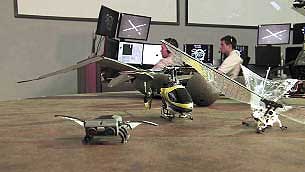
The AFIT’s Indoor Flight Test Laboratory allows researchers to simulate an urban environment, complete with building fronts and controlled winds. Composed of a test chamber and a separate control room, the lab provides a test environment where researchers can record the motion of MAV flight using a Vicon Industries-developed camera system. Using the same type of technology employed by video game developers to animate human beings, reflectors placed on MAVs enable the cameras to track position and orientation of the vehicle with an accuracy of approximately 1 mm.
“The structural problems associated with flapping flight are understood very well and have reliable methods for the predictions of the structural forces involved,” he said. “Thus, it is has been proposed that the Manduca Sexta species of hawkmoth, which fits the design space for the flapping wing micro air vehicle that I am interested in, be studied in order to characterize structural features and the subsequent aerodynamic properties for use in a FWMAV.”
According to O’Hara and Palazotto, the plan started with studying the forewing of the Manduca Sexta species using actual biological specimens. After characterizing the material properties of the veins and membrane using modal analysis and nanindentation, a pathological study of the wings was conducted by sectioning the wings. This produces cross-sectional slides, allowing the vein cross-section to be measured, as well as determining the second moment of area for each vein from root to tip.
Other research included using a Computed Tomography Machine to measure the camber of the wing in 3D, collecting mass and area information of all specimens (entire moth, head, abdomen, thorax, forewings, and hindwings), generating an FEA structural model and create an engineering wing FEA model.
Festo’s BHA project had the initial aim of developing a system for a safe human-machine interaction. Such a system should have a high flexibility and sufficient accuracy.
Bionic Handling Assistant
Biological inspiration: Elephant trunks
Developed by: Festo Corp
The Bionic Handling Assistant project was based on the development of pneumatic lightweight structures by Professor Dieter Mankau at the Offenbach Academy of Art and Design, and the additive manufactured bellow from the Fraunhofer Institute for Manufacturing Engineering and Automation in Stuttgart.
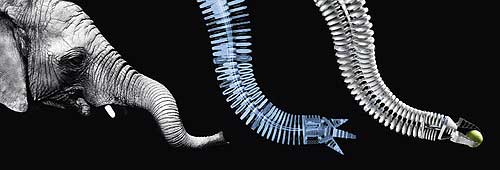
By analyzing the structure and functioning of the elephant’s trunk, and with the use of new manufacturing technologies, Festo engineers developed an entirely new biomechatronic handling system. The elephant’s trunk is a fascinating model instrument—it is flexible, transmits large forces and serves as a precise gripping tool, thanks to a hierarchically arranged system of muscles and evolutionarily optimized movement patterns.
At first glance, the BHA resembles an organic structure, reminiscent of an elephant’s trunk or a vertebral column. It consists of three basic elements for spatial movement, along with a hand axis and a gripper with adaptive fingers. Each actuator is supplied with compressed air at the interfaces of the basic elements. Resetting is effected by the loop-like design of the actuators, which act like a spring when the compressed air is discharged. Bowden cable potentiometers on the outside of the actuators register their extension and control the system’s spatial movement.
Kaminski said that an elephant’s trunk is one of the best examples in nature that shows these properties.
“One big challenge in the design process was the reduction of weight,” he said. “This was [solved] by using a polyamide processed by selective laser sintering. This material has, in general, a density less than 1g/cm3 and it was truly the key for a real lightweight construction. But also the structure of the system itself was strictly reduced to its functions as it can be observed in nature.”
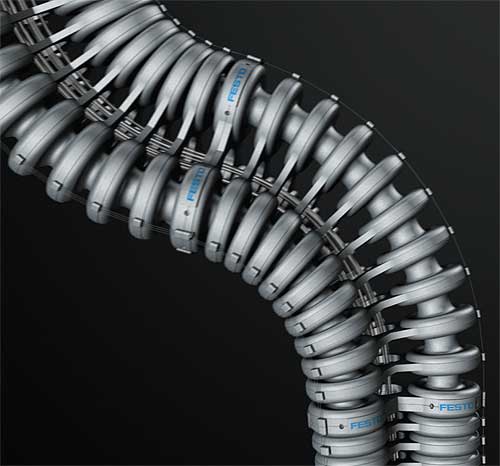
Festo’s Bionic Handling Assistant, inspired by elephant trunks, is a flexible, precise gripping tool.
Festo engineers had issues with adjustment of the wall thickness of the construction in relation to the air pressure that was needed to generate the movement. Kaminski explained that there is a complex relationship between the design of the shape of the cross-section and its effect on the movement behavior of the system.
“The integration of sensor technology was a further challenge during the development process,” Kaminski said. “In this case, we used Bowden cable potentiometers. These potentiometers were long and flexible enough to create a good signal all over the system.”
At Carnegie Mellon’s Robotics Institute, don’t expect to see terrariums in Choset’s office. For one thing, he’s afraid of them—“There’s a biological basis for that,” he said. “We’re wired at some level to fear snakes.”
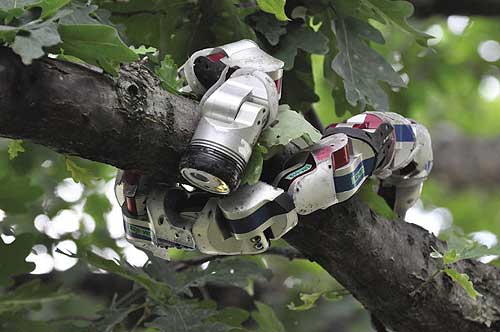
One of Carnegie Mellon’s snake robots scales a tree, showing off its impressive climbing ability.
But more importantly, Choset doesn’t use actual specimens the way that AFIT does. Some of his work builds upon earlier snake robot designs developed previously in Japan and at CalTech. He explains that there are four thrusts of his science:
• Mechanism design—how you design the robots
• Motion control—how you coordinate the inputs to make the robot go in some desired direction, along with gait/locomotion
• Path planning—figuring out where the robot should go
• Estimation—closing the loop on the motion control and the path planning
“For each of these snake robots, there was no one common story,” Choset said. “For the medical snake robot, I worried first about the design of the mechanism and then started thinking about the estimation, where is the snake robot while it’s traveling around the heart. For the locomotive snake robot, I first worry a little bit about the path planning, then the mechanism, then the motion control, then I went back to worrying about the mechanism and back to the path planning.”
In fact, Choset stressed that bouncing around between these four areas was the best thing about his work.
“That’s the great thing about robotics, it’s multidisciplinary, you can’t solve one problem in isolation. You have to jump around to get the answers,” he said. “We have a task in mind, we try to build the robot. We’d go back and try to build a better robot. Every so often, we would talk with a biologist who would give us some inspiration, but we never did a methodical examination of biological specimens.”
However, Choset’s team is planning on examining some videos of snakes in the near future, but not for the reason you might think.
“As a snake is undulating back and forth, how do they know which way is forward? We have a theory on that, which we’ve used for our snake robot,” Choset said. “We’re going to work with Dan Goldman at Georgia Tech to [film] some sidewinders and apply our theory—and see if our impression of what the snake thinks is forward is the forward direction the snake is heading.”
“Engineering and biology are learning from each other,” he said. “It’s not a one-way street from biology to us.”
Discuss this on The Engineering Exchange:

Festo
www.festo.com
Filed Under: Potentiometers, FASTENING • JOINING • locks • latches • pins, Material handling • converting, MECHANICAL POWER TRANSMISSION, Motion control • motor controls, Mechatronics, ELECTRONICS • ELECTRICAL





Tell Us What You Think!